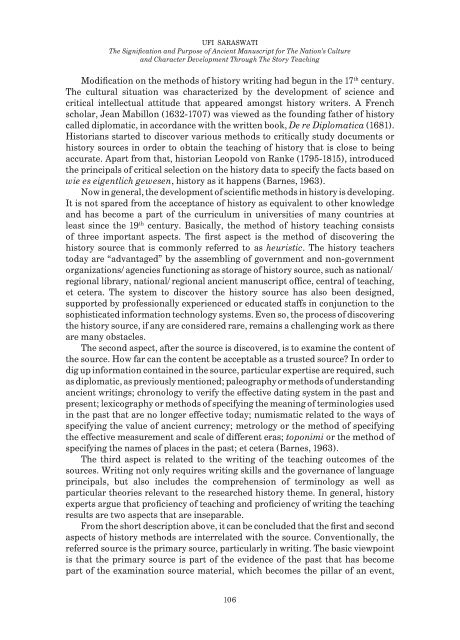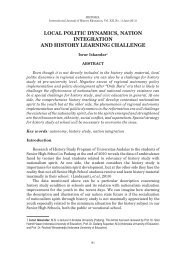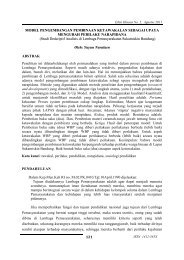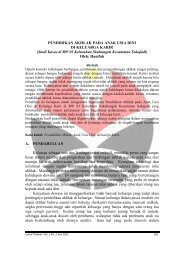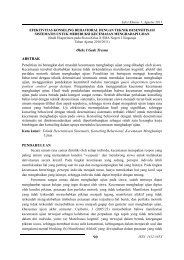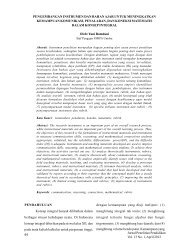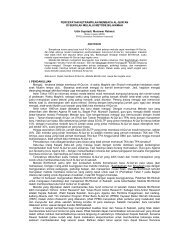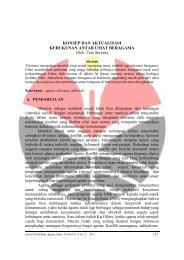Fulltext PDF - Jurnal UPI
Fulltext PDF - Jurnal UPI
Fulltext PDF - Jurnal UPI
Create successful ePaper yourself
Turn your PDF publications into a flip-book with our unique Google optimized e-Paper software.
UFI SARASWATI<br />
The Signification and Purpose of Ancient Manuscript for The Nation’s Culture<br />
and Character Development Through The Story Teaching<br />
Modification on the methods of history writing had begun in the 17 th century.<br />
The cultural situation was characterized by the development of science and<br />
critical intellectual attitude that appeared amongst history writers. A French<br />
scholar, Jean Mabillon (1632-1707) was viewed as the founding father of history<br />
called diplomatic, in accordance with the written book, De re Diplomatica (1681).<br />
Historians started to discover various methods to critically study documents or<br />
history sources in order to obtain the teaching of history that is close to being<br />
accurate. Apart from that, historian Leopold von Ranke (1795-1815), introduced<br />
the principals of critical selection on the history data to specify the facts based on<br />
wie es eigentlich gewesen, history as it happens (Barnes, 1963).<br />
Now in general, the development of scientific methods in history is developing.<br />
It is not spared from the acceptance of history as equivalent to other knowledge<br />
and has become a part of the curriculum in universities of many countries at<br />
least since the 19 th century. Basically, the method of history teaching consists<br />
of three important aspects. The first aspect is the method of discovering the<br />
history source that is commonly referred to as heuristic. The history teachers<br />
today are “advantaged” by the assembling of government and non-government<br />
organizations/agencies functioning as storage of history source, such as national/<br />
regional library, national/regional ancient manuscript office, central of teaching,<br />
et cetera. The system to discover the history source has also been designed,<br />
supported by professionally experienced or educated staffs in conjunction to the<br />
sophisticated information technology systems. Even so, the process of discovering<br />
the history source, if any are considered rare, remains a challenging work as there<br />
are many obstacles.<br />
The second aspect, after the source is discovered, is to examine the content of<br />
the source. How far can the content be acceptable as a trusted source? In order to<br />
dig up information contained in the source, particular expertise are required, such<br />
as diplomatic, as previously mentioned; paleography or methods of understanding<br />
ancient writings; chronology to verify the effective dating system in the past and<br />
present; lexicography or methods of specifying the meaning of terminologies used<br />
in the past that are no longer effective today; numismatic related to the ways of<br />
specifying the value of ancient currency; metrology or the method of specifying<br />
the effective measurement and scale of different eras; toponimi or the method of<br />
specifying the names of places in the past; et cetera (Barnes, 1963).<br />
The third aspect is related to the writing of the teaching outcomes of the<br />
sources. Writing not only requires writing skills and the governance of language<br />
principals, but also includes the comprehension of terminology as well as<br />
particular theories relevant to the researched history theme. In general, history<br />
experts argue that proficiency of teaching and proficiency of writing the teaching<br />
results are two aspects that are inseparable.<br />
From the short description above, it can be concluded that the first and second<br />
aspects of history methods are interrelated with the source. Conventionally, the<br />
referred source is the primary source, particularly in writing. The basic viewpoint<br />
is that the primary source is part of the evidence of the past that has become<br />
part of the examination source material, which becomes the pillar of an event,<br />
106


